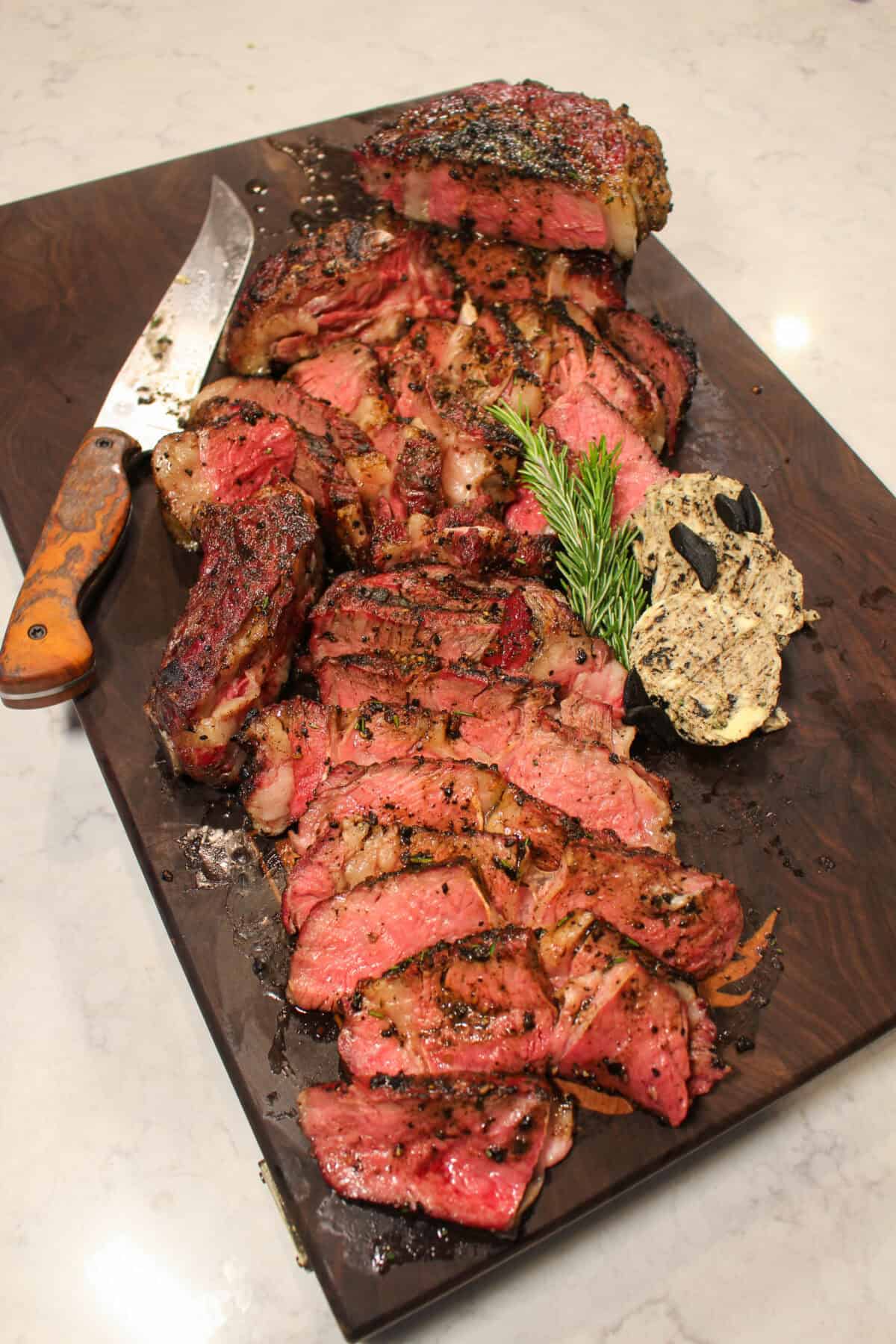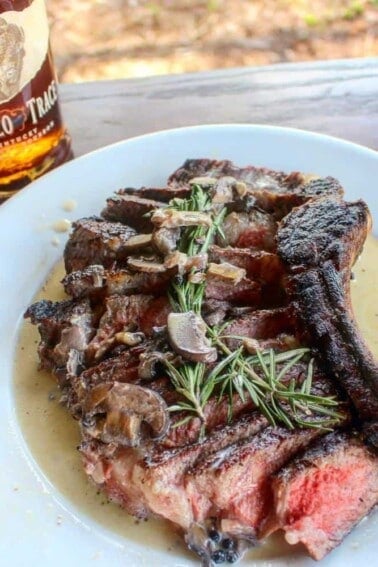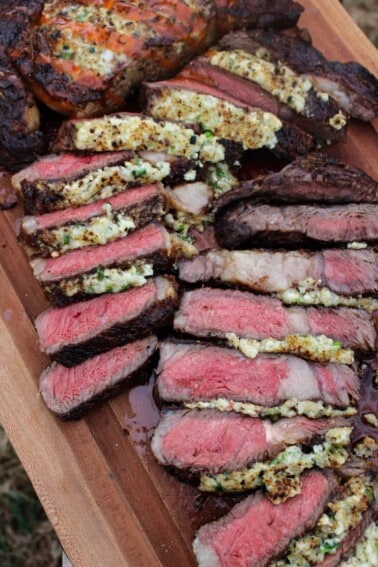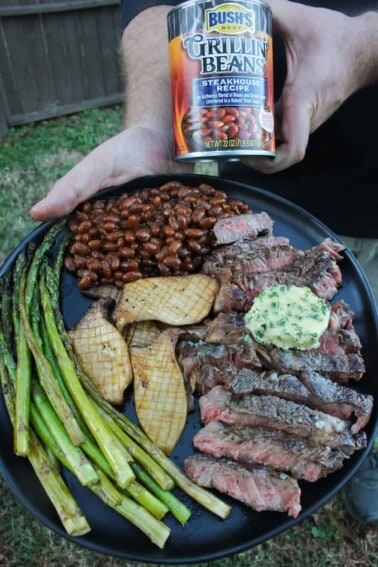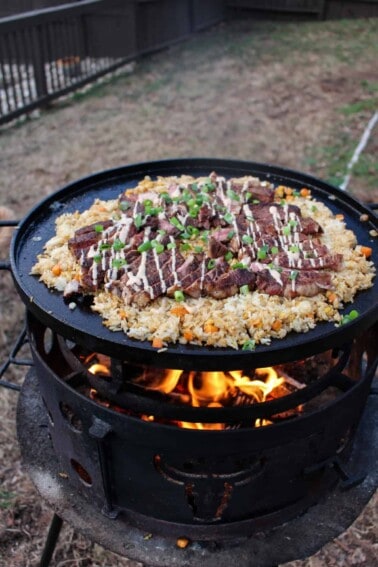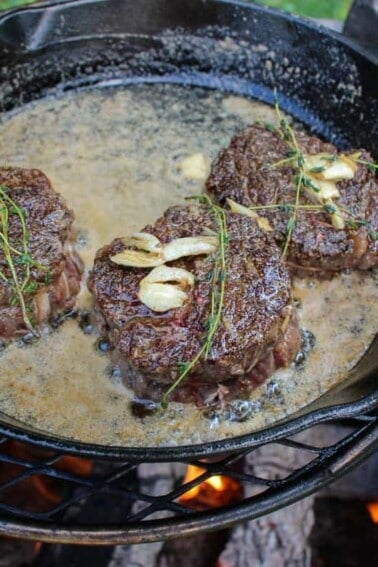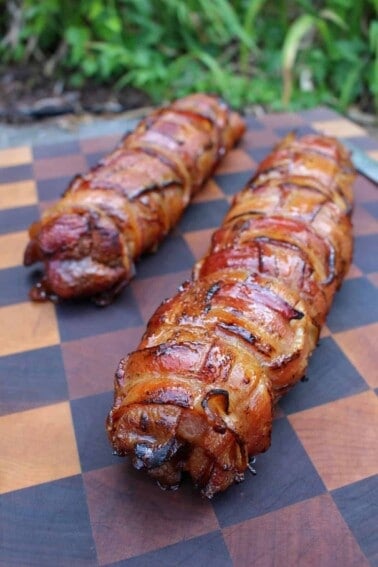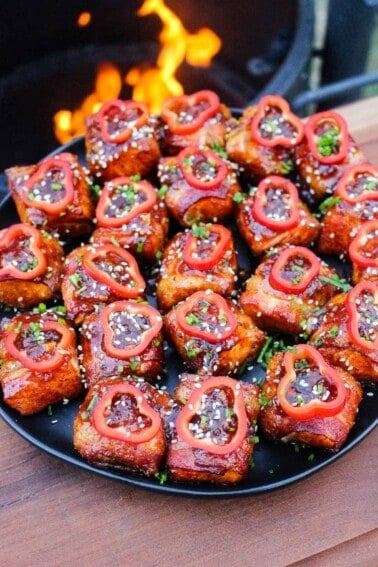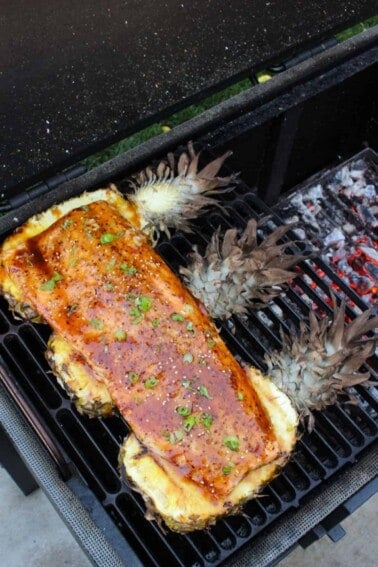If you’re looking for the ultimate method for cooking your thick-cut steak tonight, the Reverse Seared Steak is definitely the only way to go. It’s a combination of smoking and grilling that bridges the gap and delivers epic, mouthwatering results!
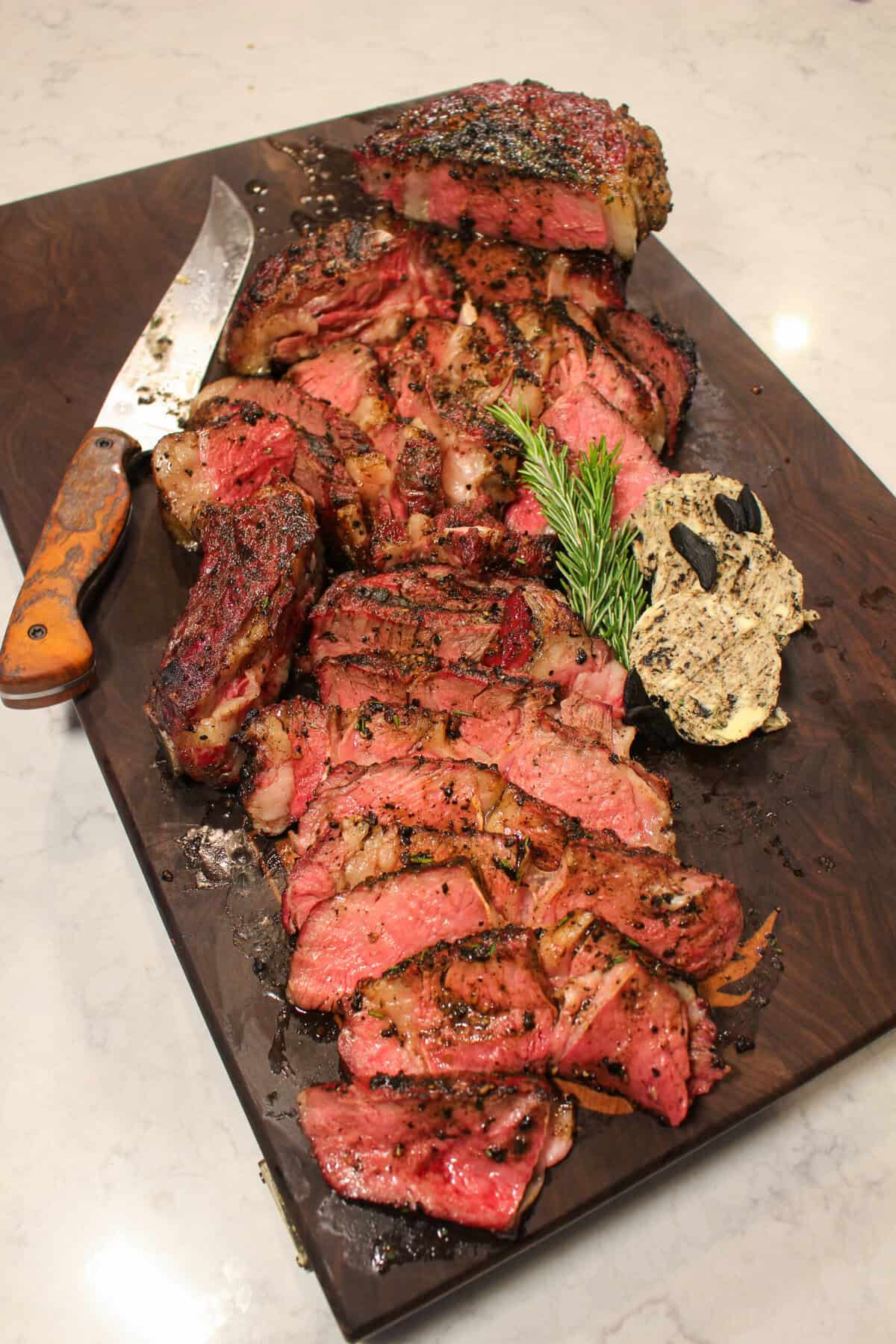
Post Sponsored by Cowboy Charcoal.
You’ll have to savor this one slowly, bite after bite. It’s the juicy steak of your dreams, with an edge-to-edge medium-rare center and an epic flavorful crust. If you’re new to cooking steak or a seasoned pro, get ready for the best way to achieve a perfectly cooked steak every time.
Table of Contents
- Why You’ll Love Reverse-Seared Steak
- Best Charcoal for Cooking Steak
- Ingredients Needed for Reverse-Seared Steak
- Simple Ways to Level Up the Flavor
- How to Make the Reverse-Seared Steak
- Low & Slow
- Blazing Sear
- What to Serve with Steak
- More ribeye steak recipes
- Leftovers & Reheating Instructions for reverse-sear Steak
- FAQs for Reverse-Seared Steak
- This sauce is FYR!
- Reverse Seared Steak Recipe
- Flavor X Fire & FOOD X Fire
Why You’ll Love Reverse-Seared Steak
If you love steak, the reverse-sear cooking method is a game-changer. The process starts by slowly bringing the steak up to the ideal temperature over low heat before finishing with a quick sear over high temperature. This creates a killer temperature gradient inside the steak, preventing the dreaded overcooked steak situation. No gray bands here! If you really want a deep dive into this process, check out my How to Reverse Sear a Steak article!
Plus, the reverse-seared steak recipe gives you that Maillard reaction magic for a nice crust on the exterior of the steak. Unlike the traditional method, where you sear first and then finish in the oven, this process locks in the juices and gives you an even better sear. Trust me, once you try it, you’ll never go back.
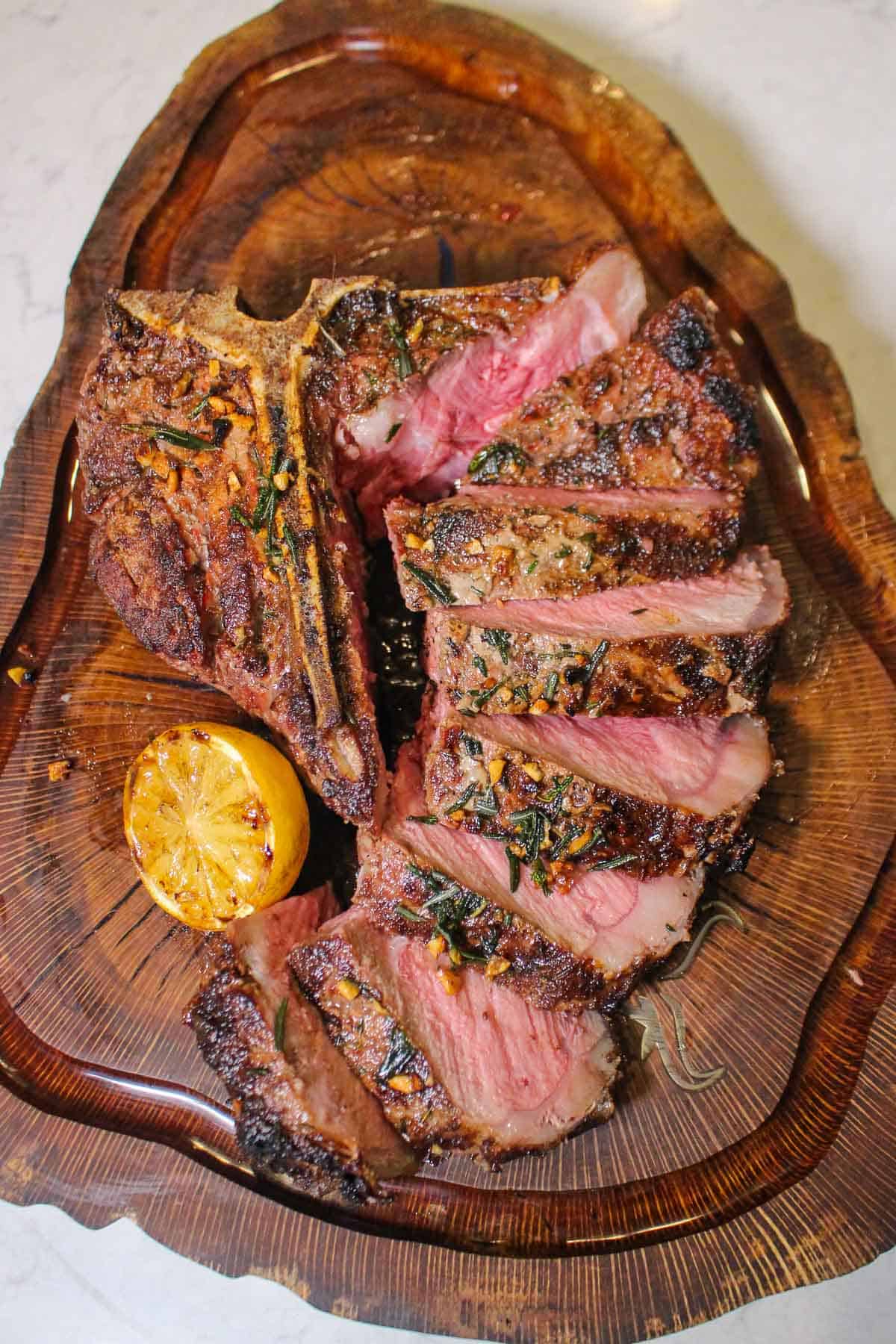
Another reason to love this cooking method? It’s incredibly forgiving. If you’ve ever panicked over an expensive cut of meat, wondering if you were about to turn it into a dry, overdone disaster, this is your fail-safe approach. You get more control over the cooking process, meaning even if you’re new to steak-making, you can pull off a perfect medium-rare with confidence.
Once you become a diehard reverse-sear steak lover, you’ll want to cook the Best Steaks for Reverse Searing.
Best Charcoal for Cooking Steak
The charcoal you use can make or break your steak, and Cowboy Charcoal is the way to go for that bold, smoky flavor. Its hardwood lump charcoal burns hotter and cleaner than traditional briquettes, giving you superior results.
For reverse searing, maintaining a steady low temperature during the roasting phase is key before cranking up the heat for the final sear. Cowboy Charcoal gives you the precision and control needed to nail that perfect crust every time.
For even more flavor, we’re tossing in some of their Hickory Wood Chunks, but if you’re after a milder, slightly sweet smoke, Apple Wood Chunks are another great option.
Ingredients Needed for Reverse-Seared Steak
- Steak – The best steaks for this method are thicker steaks like ribeye steak, filet mignon, or New York strip steaks.
- Seasoning – Kosher salt, black pepper, and sea salt.
Now that you know all the simple ingredients for making a great steak, let’s fire up that grill and get cookin’!

Simple Ways to Level Up the Flavor
Want to take your reverse-seared steak to the next level? Try brushing fresh rosemary and garlic over the outer layers while searing. A herb brush with some garlic butter is my favorite way to do this! This infuses the steak with next-level aromatics and deep, savory flavors and helps achieve an even better sear.
Another trick? Let the steak rest for about five minutes after searing, but don’t just let it sit there. While it’s resting, place a slab of butter on top and let it melt slowly into the crust. It’ll soak in beautifully, adding richness while keeping the steak ultra juicy.
Looking for some heat? Drizzle on some of FYR Hot Sauce for an extra kick that’ll make your taste buds dance.
How to Make the Reverse-Seared Steak
Grill Prep
Start by lighting up some Cowboy Hardwood Lump Charcoal in a charcoal chimney, or just mound it inside your grill. Let it burn for about 10-15 minutes until you’ve got a nice hot bed of coals. If you want to add a little extra smoky flavor, toss in a few small pieces of hickory wood on top of the charcoal—totally optional but highly recommended.
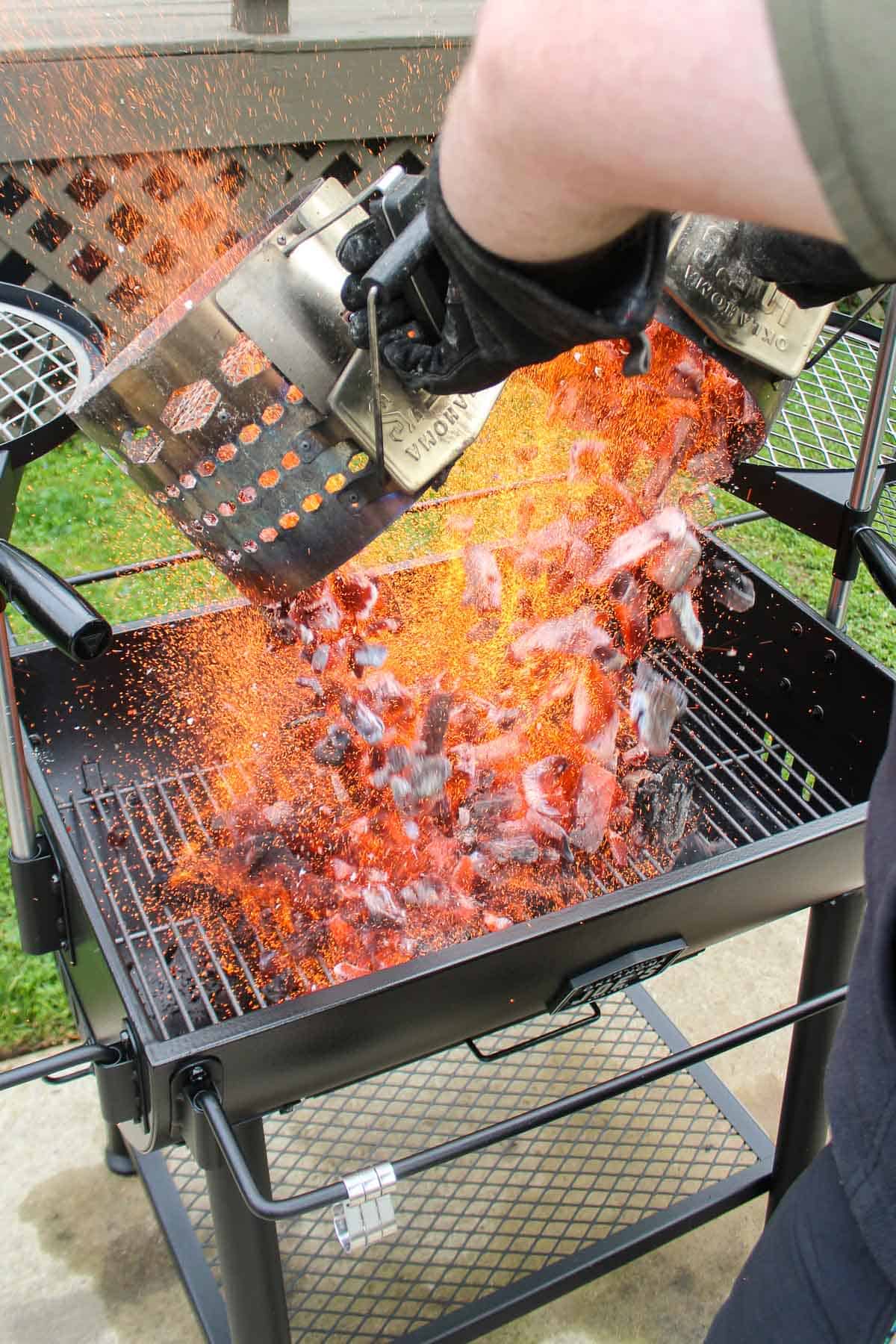
Once the charcoal is hot and ready to go, move it over to one side of the grill, leaving enough space so you can add more charcoal or wood later if needed. Close the lid and give the grill a few minutes to heat up. You’re aiming for a steady temperature of around 225F before you start cooking.
Low & Slow
While you’re waiting for the grill to come up to temp, season your steak on both sides with salt and pepper (or your favorite steak seasoning). When the grill is ready, place the steak on the opposite side of the charcoal for indirect heat.
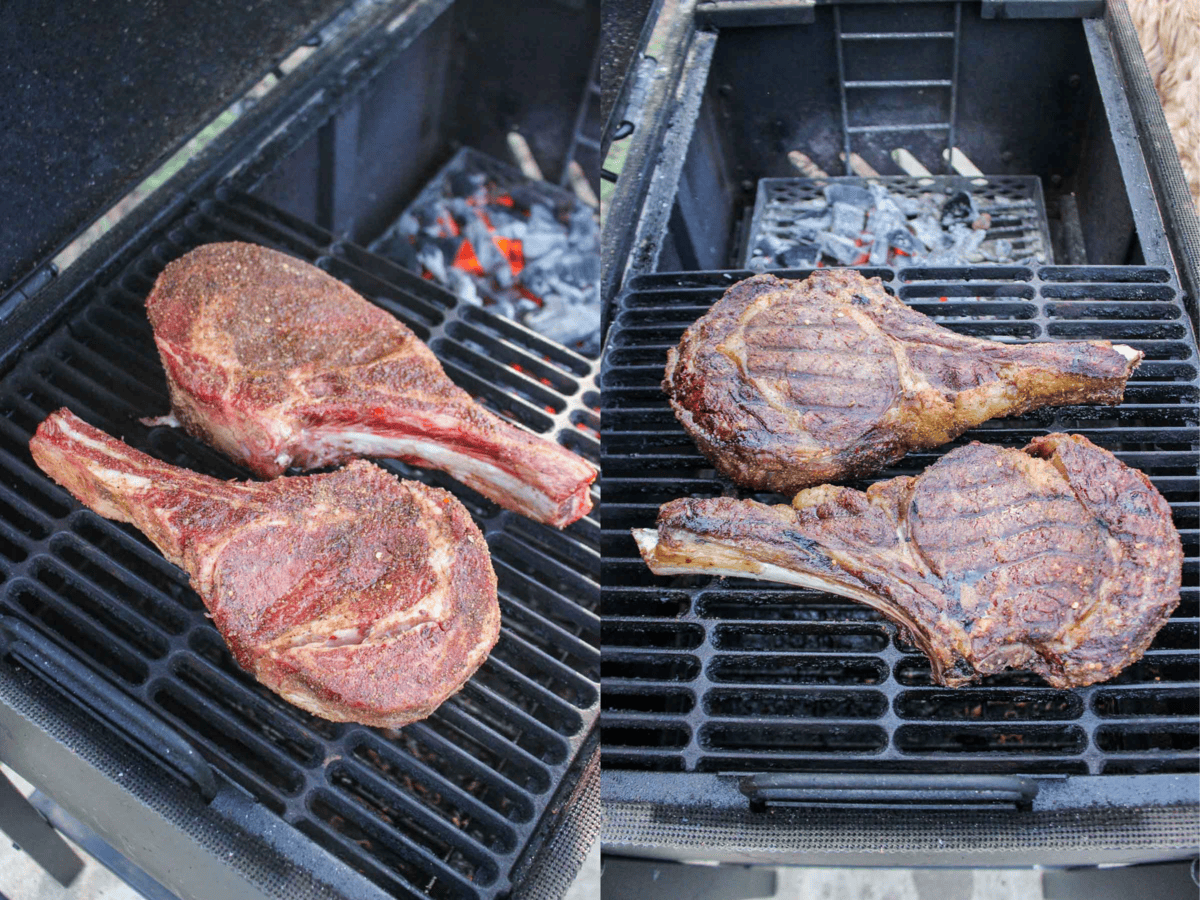
Now, let that steak do its thing. It’ll need to smoke for about 45-50 minutes or until the internal temperature hits 120F for a perfect medium-rare. Keep an eye on your heat and add more charcoal or wood chunks as needed to keep things steady. The slow cooking is what makes the reverse-sear method so good, so be patient!
Blazing Sear
Once your steak reaches the target temp, pull it off the grill and let it rest for about 10 minutes. While it’s resting, get that grill cranked up as hot as possible. You want a screaming hot pan for the final sear.
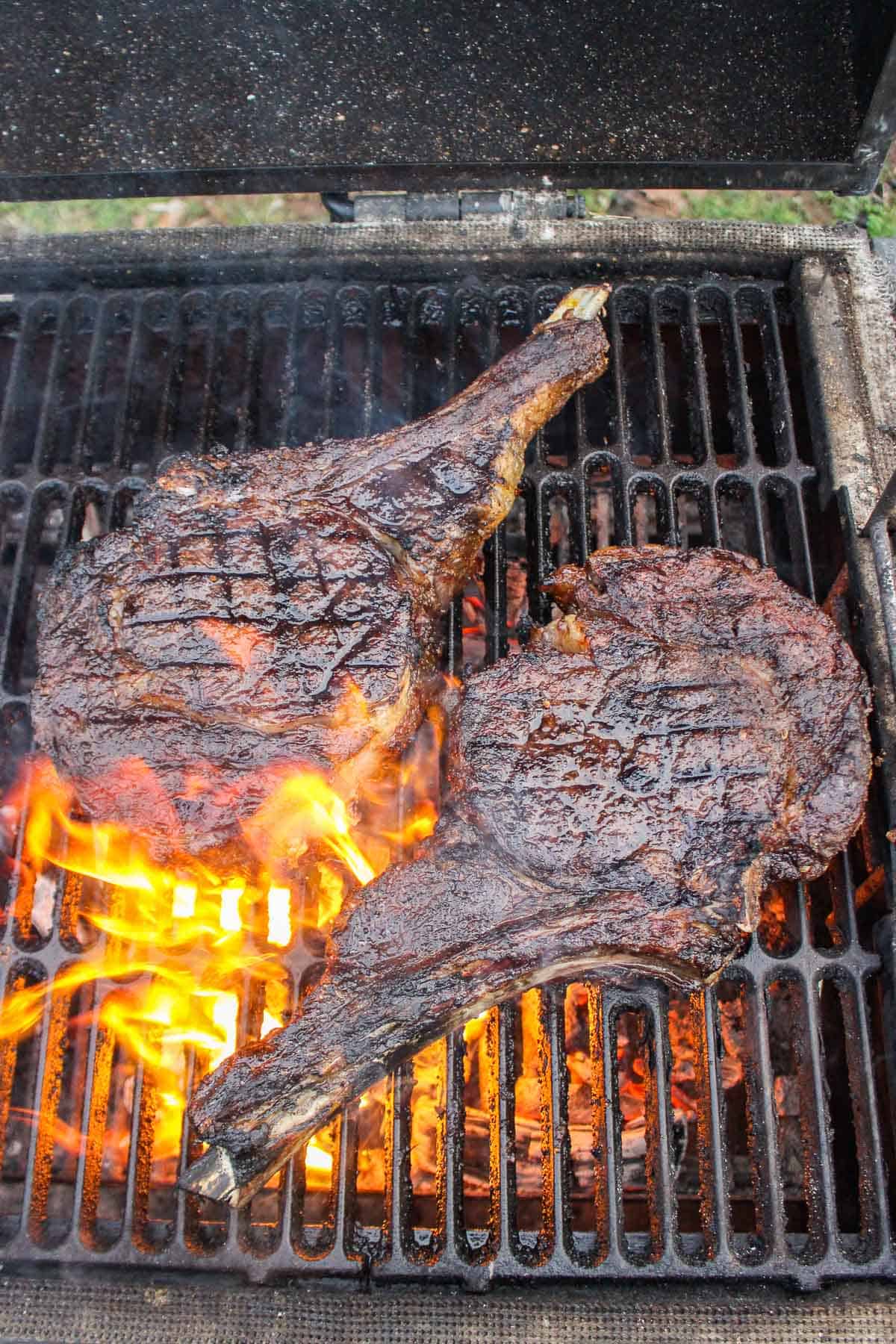
When the fire is ready, place the steak directly over the heat and sear it for one minute per side. Want those picture-perfect grill marks? Rotate the steak 90 degrees after 30 seconds, then flip and repeat on the other side. That Maillard reaction is what gives you that incredible crust, so don’t skip this step!
Once your steak is beautifully seared, slice it up, serve it hot, and enjoy every bite. This is next-level steak, and you’ve just mastered the best way to cook it! Cheers to that!
What to Serve with Steak
Now that you’ve got a perfect steak, let’s talk sides. A good quality steak deserves some epic pairings. Try crispy roasted potatoes, garlic butter mushrooms, or a fresh arugula salad. If you’re feeling bold, throw in some hot charcoal fire-grilled asparagus. Don’t forget a glass of red wine or an ice-cold beer. Cheers!
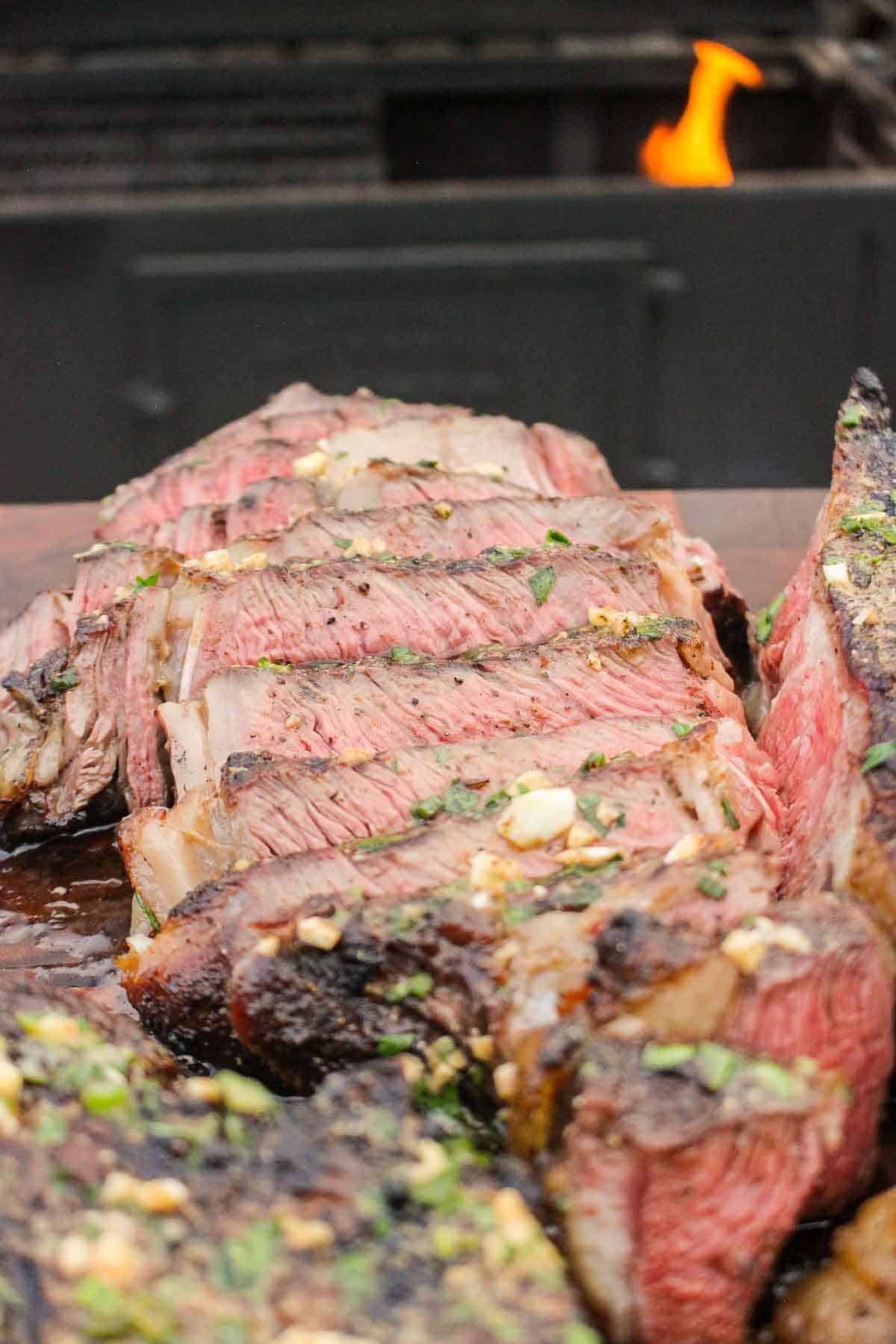
For a heartier meal, consider adding creamy mashed potatoes, skillet cornbread, or a baked sweet potato with cinnamon butter. And if you’re really feeling indulgent, make a batch of truffle fries to pair with your perfectly cooked steak.
More ribeye steak recipes
Leftovers & Reheating Instructions for reverse-sear Steak
Got leftovers? No problem. Store your steak in an airtight container in the fridge for up to three days. To reheat, skip the microwave—it’ll ruin your good steak. Instead, warm it in the grill inside an aluminum foil envelope with some bone broth or beer at about 225 degrees F until it reaches the perfect temperature. Or, give it a quick sear in a frying pan with a touch of olive oil to bring back that killer crust.
Another pro tip? Slice it thin and serve it cold over a steak salad the next day. A little blue cheese, some arugula, and a drizzle of balsamic glaze turn your leftovers into a restaurant-worthy meal. You could also turn it into a delicious Steak Sandwich.
Add flavor to everything you’re cooking
shop over the fire spice lines
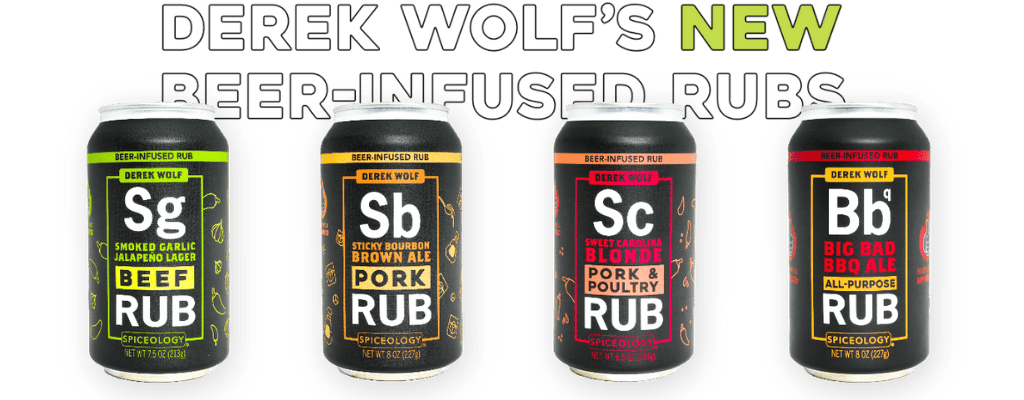
FAQs for Reverse-Seared Steak
Absolutely! This cooking technique works great for thicker steaks like filet mignon, New York strip steaks, picanha and even porterhouse. Just remember, the thickness of your piece of meat will affect the amount of time needed to reach the ideal temperature.
Your desired internal temperature depends on how you like your steak cooked. For a rare steak, aim for 110-115F, while medium-rare falls between 120-125F. If you prefer medium, go for 130-135F, and for medium-well, target 140-145F. Well-done steaks should reach 150F or higher. If you’re using a meat thermometer, always pull the steak off the heat a few degrees before your target temperature, as it will continue to cook while resting, ensuring a perfectly cooked result.
The Maillard reaction is what gives steak its rich, flavorful crust. It happens when the amino acids and natural sugars in the muscle fibers react to high heat, creating deep browning and complex flavors. Thicker cuts like ribeye or filet mignon benefit most, and using special equipment like a cast iron or stainless steel pan ensures even heat for the perfect sear. For the best results, make sure your pan or grill is extremely hot before searing.
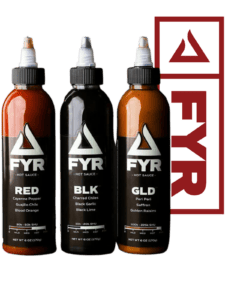
Get stoked for life
This sauce is FYR!
Born from a deep passion for food and flavor. Whether you’re grilling in the backyard or live fire cooking around the world, we have what you need to transform every meal into an adventure.

Reverse Seared Steak
Ingredients
- 1 Ribeye steak about 12-16oz
- 1 tbsp sea salt
- 1 tbsp fresh black pepper
- 1 tbsp cinnamon
- Other: A grill that can smoke on low heat i.e. anything with a lid
Instructions
- Light the Cowboy Hardwood Lump Charcoal in a charcoal chimney or mound inside your grill and let burn for 10-15 minutes. (Optional) Add 3-4 small pieces of hickory wood to the top of the charcoal for added flavor!
- Once charcoal is hot, place in grill on one side and leave room so that you can add more charcoal/wood later. Close the lid on your grill and wait for the temperature to reach 225F.
- While waiting, season the steak with salt, pepper, and cinnamon on both sides. When temperature is ready, place steak on opposite side of charcoal.
- Let the steak roast for about 45-50 minutes (or until the internal temperature for steak is 120F). Make sure to add charcoal/wood chunks to maintain a consistent temperature!
- Pull steak off grill and let rest for 10 minutes. While steak is resting, prep your grill to be as hot as possible!
- When fire is ready, place steaks on grill for 1 minute per side. For cross grill marks, do 30 seconds on one side then turn 90 degrees for another 30 seconds. Flip steak and repeat process.
- Slice, serve and enjoy!
Notes
Best Charcoal for Cooking Steak
The charcoal you use can make or break your steak, and Cowboy Charcoal is the way to go for that bold, smoky flavor. Its hardwood lump charcoal burns hotter and cleaner than traditional briquettes, giving you superior results whether you’re using a pellet grill, cast iron skillet, or an open fire. For reverse searing, maintaining a steady low temperature during the roasting phase is key before cranking up the heat for the final sear. Cowboy Charcoal gives you the precision and control needed to nail that perfect crust every time. For even more flavor, we’re tossing in some of their Hickory Wood Chunks, but if you’re after a milder, slightly sweet smoke, Apple Wood Chunks are another great option.Nutrition
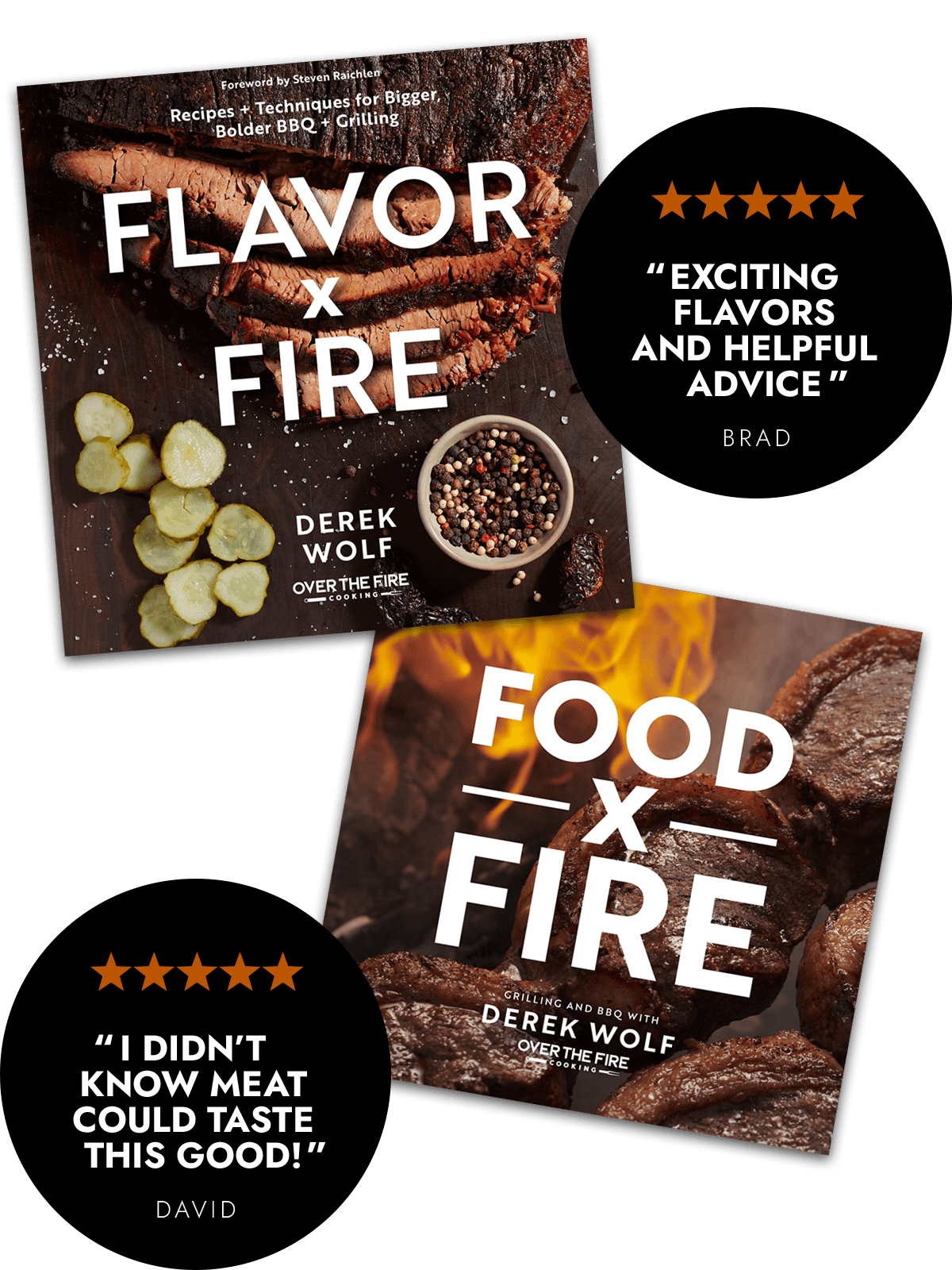
Get The Cookbooks!
Flavor X Fire & FOOD X Fire
All the major tastes—salty, sour, sweet, bitter, and umami—are explored in depth, along with an investigation of other components you should consider when it comes to flavor, such as aroma, heat, and texture.
